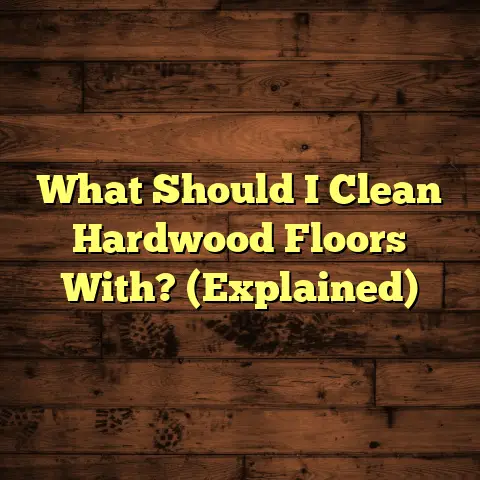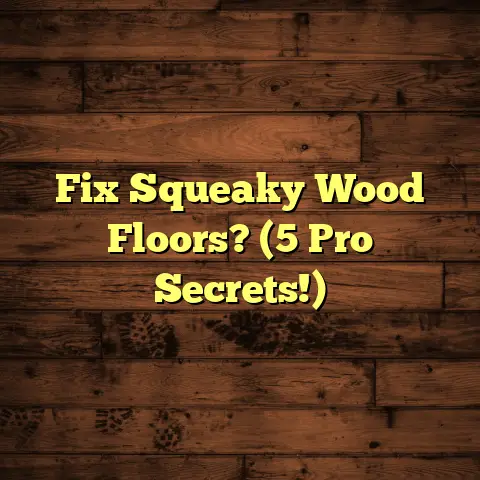Pulling Up Carpet? (8 Hardwood Hazard Alerts!)
If you’re thinking about ripping up that old carpet and revealing the hardwood floors beneath (or prepping for new ones!), you’re probably dreaming of that clean, modern look.
And you’re right to be excited!
But before you grab that crowbar, let’s talk about some potential pitfalls.
Trust me, knowing these hazards beforehand can save you a lot of headaches, and maybe even a trip to the emergency room.
Let’s dive in!
The Allure of Hardwood: Why Ditch the Carpet?
Okay, let’s be honest – carpets can be cozy. But they can also be a breeding ground for things you really don’t want to live with.
Think about it: all that foot traffic grinds dirt, dust, and allergens deep into the fibers.
And no matter how often you vacuum, some of that gunk is staying put.
But does it really matter?
Absolutely!
Health Benefits of Removing Carpet
Carpets are notorious for trapping:
- Dust mites: These microscopic critters thrive in carpets and are a major trigger for allergies and asthma. According to the Asthma and Allergy Foundation of America, about 20 million Americans are allergic to dust mites.
- Pet dander: Even if you don’t see it, your furry friends are constantly shedding. Carpet fibers act like Velcro for pet dander, making it difficult to remove completely.
- Mold spores: Carpets in damp areas, like basements or bathrooms, are prime real estate for mold growth.
- Volatile Organic Compounds (VOCs): Many carpets are made with synthetic materials that release VOCs into the air. These chemicals can cause headaches, dizziness, and respiratory irritation.
Switching to hardwood floors can significantly improve your indoor air quality.
Hardwood is easy to clean, doesn’t trap allergens, and doesn’t harbor mold as easily as carpet.
In fact, a study by the EPA found that replacing carpets with hard surface flooring can reduce allergen levels by up to 50%!
So, if you or someone in your family suffers from allergies, asthma, or other respiratory issues, removing your carpet could be a game-changer.
Benefits of Hardwood Flooring: Beyond Health
Let’s face it, health benefits are great, but aesthetics matter too!
Hardwood floors offer a ton of advantages beyond just cleaner air:
- Durability: Hardwood floors are incredibly durable and can last for decades with proper care.
- Easy Cleaning: A quick sweep or mop is all it takes to keep hardwood floors looking their best.
- Timeless Style: Hardwood floors add a touch of elegance and sophistication to any home.
- Increased Home Value: Hardwood floors are a highly desirable feature that can increase the value of your home.
- Versatility: There are countless styles, colors, and finishes of hardwood flooring to choose from, so you can find the perfect look for your home.
Preparing to Pull Up Carpet: Safety First!
Okay, you’re convinced. Carpet’s gotta go!
But before you start ripping, let’s talk about preparation. This is crucial for your safety and the success of your project.
- Ventilation is Key: Open windows and doors to ensure proper ventilation.
This will help to minimize dust inhalation.
Consider using fans to circulate the air. - Personal Protective Equipment (PPE):
- Wear a dust mask or respirator to protect your lungs from dust and allergens.
- Wear safety glasses to protect your eyes from flying debris.
- Wear gloves to protect your hands from sharp objects and chemicals.
- Clear the Area: Remove all furniture and other items from the room.
This will give you plenty of space to work and prevent damage to your belongings. - Tools of the Trade: Gather the necessary tools, including:
- Utility knife
- Pry bar
- Pliers
- Hammer
- Gloves
- Eye protection
- Dust mask
- Trash bags
Hazard Alert #1: Exposed Nails and Tacks: Ouch!
One of the most common hazards you’ll encounter when pulling up carpet is exposed nails and tacks.
These little guys are sharp and can cause serious injuries if you’re not careful.
They’re usually located around the perimeter of the room, where the carpet was secured to the tack strip.
- The Risk: Stepping on an exposed nail or tack can result in a puncture wound, which can be painful and prone to infection.
- The Solution:
- Wear thick-soled shoes or work boots to protect your feet.
- Use a pry bar to carefully lift the carpet away from the tack strip.
- Use pliers to remove any exposed nails or tacks.
- Dispose of the nails and tacks safely in a puncture-proof container.
- Consider wearing knee pads to protect your knees while working close to the ground.
I always recommend doing a thorough sweep of the area with a magnet after removing the carpet.
You’d be surprised how many stray nails and tacks you can find!
Hazard Alert #2: Dust and Allergens: Prepare to Sneeze!
As I mentioned earlier, carpets are notorious for trapping dust and allergens.
When you pull up the carpet, all of that accumulated gunk is going to be released into the air.
Get ready for a sneeze-fest!
- The Risk: Inhaling dust and allergens can trigger allergic reactions, asthma attacks, and other respiratory problems.
- The Solution:
- Wear a high-quality dust mask or respirator to protect your lungs.
- Use an air purifier with a HEPA filter to remove dust and allergens from the air.
- Vacuum the area thoroughly after removing the carpet.
- Consider hiring a professional cleaning service to deep clean the area.
- If you have severe allergies or asthma, consider having someone else remove the carpet for you.
Hazard Alert #3: Mold and Mildew: The Hidden Enemy
This is where things can get really nasty. If your carpet has been exposed to moisture, there’s a good chance that mold or mildew is lurking underneath.
And trust me, you don’t want to mess with mold.
- The Risk: Mold exposure can cause a variety of health problems, including respiratory infections, allergic reactions, and even neurological damage.
- The Solution:
- Look for signs of mold or mildew, such as discoloration, musty odors, or visible growth.
- If you find mold, do not attempt to remove it yourself.
- Contact a professional mold remediation company to safely remove the mold and prevent it from spreading.
- Address the source of the moisture to prevent future mold growth.
I once pulled up carpet in a basement and found a whole colony of mold growing underneath.
It was a biohazard nightmare!
Don’t take chances with mold. Get it handled by the pros.
Hazard Alert #4: Chemical Residues: What’s Lurking in the Fibers?
Over the years, your carpet has probably been exposed to a variety of chemicals, from carpet cleaning products to stain repellents.
These chemicals can leave behind residues that can be harmful to your health.
- The Risk: Exposure to chemical residues can cause skin irritation, respiratory problems, and other health issues.
- The Solution:
- Wear gloves to protect your skin from contact with chemical residues.
- Ventilate the area thoroughly to remove chemical odors.
- Consider using a HEPA vacuum to remove any remaining chemical residues.
- If you’re concerned about chemical exposure, consider hiring a professional cleaning service to deep clean the area.
Hazard Alert #5: Inadequate Subflooring: Uh Oh, What’s Underneath?
Once you remove the carpet, you’ll be able to see the subflooring underneath.
The subfloor is the foundation for your new flooring, so it’s important to make sure it’s in good condition.
If the subfloor is damaged or inadequate, it can cause problems with your new flooring down the road.
- The Risk: Damaged subflooring can lead to uneven floors, squeaks, and even structural problems.
- The Solution:
- Inspect the subfloor for signs of damage, such as cracks, rot, or water stains.
- If you find any damage, repair or replace the subfloor before installing new flooring.
- Make sure the subfloor is level and smooth.
- If the subfloor is not level, you may need to use a self-leveling compound to create a smooth surface.
I’ve seen some pretty scary subfloors in my day. From termite damage to water damage, you name it.
Don’t skip this step!
A solid subfloor is essential for a long-lasting and beautiful floor.
Hazard Alert #6: Old Carpet Padding: A Breeding Ground for… Who Knows What?
Carpet padding provides cushioning and insulation, but it can also be a breeding ground for dust mites, mold, and other allergens.
Old carpet padding can also contain harmful substances, such as flame retardants and VOCs.
- The Risk: Exposure to old carpet padding can cause allergic reactions, respiratory problems, and other health issues.
- The Solution:
- Remove the old carpet padding carefully and dispose of it properly.
- Wear a dust mask and gloves to protect yourself from dust and allergens.
- Consider replacing the old carpet padding with a new, hypoallergenic padding.
Always get rid of the old padding. It’s just not worth keeping around.
Hazard Alert #7: Heavy Furniture and Equipment: Don’t Break Your Back!
Removing carpet often involves moving heavy furniture and equipment.
This can be a major safety hazard if you’re not careful.
- The Risk: Lifting heavy objects can cause back injuries, muscle strains, and other musculoskeletal problems.
- The Solution:
- Get help from others when moving heavy objects.
- Use proper lifting techniques: bend your knees, keep your back straight, and lift with your legs.
- Use furniture sliders or dollies to move heavy objects more easily.
- Take breaks often to avoid fatigue.
I’ve seen too many homeowners throw out their back trying to move a couch by themselves.
Don’t be a hero! Get some help.
Hazard Alert #8: Flooring Transition Issues: Watch Your Step!
Transitioning from carpet to hardwood can create uneven surfaces and trip hazards.
This is especially true if the carpet was thicker than the hardwood flooring.
- The Risk: Uneven surfaces can cause trips, falls, and other injuries.
- The Solution:
- Use transition strips to create a smooth transition between different flooring types.
- Make sure the transition strips are securely fastened to the floor.
- Consider using a self-leveling compound to create a level surface before installing the hardwood flooring.
- Be mindful of the transition areas and warn others about the potential trip hazard.
Transition strips are your friend! They not only look good, but they also prevent accidents.
Conclusion: Breathe Easy and Enjoy Your New Floors!
So, there you have it: eight hardwood hazard alerts to keep in mind when pulling up carpet.
I know it sounds like a lot, but with proper preparation and caution, you can safely remove your carpet and enjoy the many benefits of hardwood flooring.
Remember, the health benefits alone are worth the effort.
A cleaner, healthier home is a happier home.
Don’t let these potential hazards scare you away from your dream floors.
Just be aware, be prepared, and be safe!
And if you’re feeling overwhelmed, don’t hesitate to call a professional.
We’re here to help!
Now go forth and create the beautiful, healthy home you deserve!





